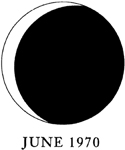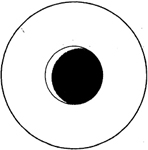
My model for transcendence looks different from Dianne’s and may look very different from yours. Although some of my losses were expected and others completely shocking, my basic way of dealing with them was the same.
The first drawing is a model of my grief on the day my firstborn died, June 4, 1970. The circle represents my entire self, and the markings inside the circle represent my grief. Notice that my sorrow fills almost the entire circle.

My personal model of grief on June 4, 1970 The circle, representing my entire being, was almost totally filled with grief. Only the small portion on the left remained untouched by the death of my newborn child.
By 1990, I thought of my loss in terms of inner and outer circles, as in the second diagram. The inner circle represented my grief. The outer circle, the whole of me, had expanded beyond my former self. My son’s death was no longer overwhelming. It had become only one component of my makeup, along with other losses and life events.

My 1990 model for personal transcendence The inner circle, representing my grief, remained the same as on the day my firstborn died. However, it became much lighter and less defined. The outer circle, representing my whole self, grew around that loss.
As with most people, each new loss I experience brings a ripple effect. My grief intensifies because the past resurfaces. In January 1996, for example, as my brother Randy took his last breath, my mind flashed back to some fifty years earlier.
I was a little boy again, looking at a pale blue blanket. Mother opened the corner for me to catch a glimpse of my newborn baby brother, but all I could see were Randy’s distinctive bald head and ears. In my mind’s eye, I then revisited our hometown and imagined that my wonderful life in Porterdale, Georgia, was never-ending.
Now, along with mourning Randy’s death, I longed for that wonderful cast of characters from our childhood.
Circumstances other than the death of a loved one can cause my grief to intensify. When my surviving sons graduated, I thought about their brother and what could have been. Then, while I was preparing for Avery’s wedding in May 1999, the anniversary date of my firstborn’s death approached. Among the many losses that ran rampant in my mind was my failed marriage to his mother. I drew the following as a representation of my grief at that time.

My grief in May 1999 While I was preparing for Avery’s wedding, the anniversary date of my first son’s death was approaching. I felt more grief at this time than on the day he died. Apart from the minute area on the left, intense grief filled the inner circle.
Grief for my firstborn will always remain part of my psychological makeup. On a normal day, my sorrow (represented by the inner circle) is much less defined. My whole self (represented by the outer circle) will continue to grow and expand.

My transcendence: August 2000 The outer circle, my whole self, is larger than ever before. I keep growing and expanding from my loss.
Although each loss was different for me, I dealt with all of them by intellectualizing, controlling my emotions, and walking.1 This is the common method for many men, but not all. Some deal with loss as Dianne does; that is, their transcendence is based on feelings, spirituality, and leaving grief behind.